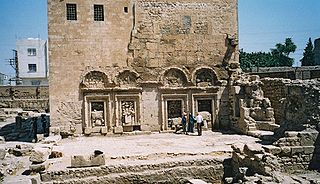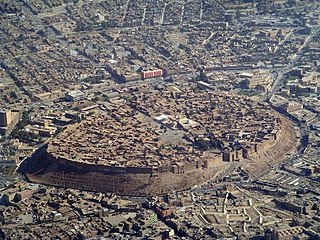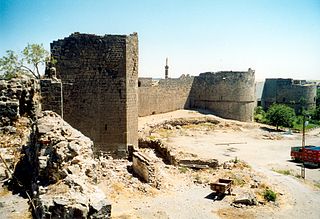Related Research Articles

At the height of its power, in the 10th century AD, the dioceses of the Church of the East numbered well over a hundred and stretched from Egypt to China. These dioceses were organised into six interior provinces in Mesopotamia, in the Church's Iraqi heartland, and a dozen or more second-rank exterior provinces. Most of the exterior provinces were located in Iran, Central Asia, India and China, testifying to the Church's remarkable eastern expansion in the Middle Ages. A number of East Syriac dioceses were also established in the towns of the eastern Mediterranean, in Palestine, Syria, Cilicia and Egypt.
Dioceses of the Church of the East, 1318–1552 were metropolitan provinces and dioceses of the Church of the East, during the period from 1318 to 1552. They were far fewer in number than during the period of the Church's greatest expansion in the tenth century. Between 1318 and 1552, the geographical horizons of the Church of the East, which had once stretched from Egypt to China, narrowed drastically. By 1552, with the exception of a number of East Syriac communities in India, the ecclesiastical jurisdiction of the Church of the East was confined to its original heartland in northern Mesopotamia.
The Metropolitanate of Maishan or Maysan was an East Syriac metropolitan province of the Church of the East between the fifth and thirteenth centuries. The historical region of Maishan or Maysan is situated in southern Iraq. The metropolitans of Maishan sat at Prath d'Maishan, and for most of its history the province had three suffragan dioceses, at Karka d'Maishan, Rima and Nahargur. The last metropolitan of Maishan, the noted East Syriac author Shlemun (Solomon) of Basra, is attested in 1222, and it is not clear when the province ceased to exist.

Metropolitanate of Beth Garmai was an East Syriac metropolitan province of the Church of the East between the fifth and fourteenth centuries. The region of Beth Garmai is situated in northern Iraq, bounded by the Little Zab and Diyala Rivers and centered on the town of Karka d'Beth Slokh. Several bishops and metropolitans of Beth Garmaï are mentioned between the fourth and fourteenth centuries, residing first at Shahrgard, then at Karka d'Beth Slokh, later at Shahrzur and finally at Daquqa. The known suffragan dioceses of the metropolitan province of Beth Garmaï included Shahrgard, Lashom (ܠܫܘܡ), Khanijar, Mahoze d'Arewan, Radani, Hrbath Glal (ܚܪܒܬܓܠܠ), Tahal and Shahrzur. The suffragan dioceses of 'Darabad' and 'al-Qabba', mentioned respectively by Eliya of Damascus and Mari, are probably to be identified with one or more of these known dioceses. The diocese of Gawkaï, attested in the eighth and ninth centuries, may also have been a suffragan diocese of the province of Beth Garmaï. The last known metropolitan of Beth Garmaï is attested in the thirteenth century, and the last known bishop in 1318, though the historian ʿAmr continued to describe Beth Garmai as a metropolitan province as late as 1348. It is not clear when the province ceased to exist, but the campaigns of Timur Leng between 1390 and 1405 offer a reasonable context.

The Patriarchal Province of Seleucia-Ctesiphon was an ecclesiastical province of the Church of the East, with see in Seleucia-Ctesiphon. It was attested between the fifth and thirteenth centuries. As its name entails, it was the province of the patriarch of the Church of the East. The province consisted of a number of dioceses in the region of Beth Aramaye, between Basra and Kirkuk, which were placed under the patriarch's direct supervision at the synod of Yahballaha I in 420.

The Metropolitanate of Nisibis was an East Syriac metropolitan province of the Church of the East, between the fifth and seventeenth centuries. The ecclesiastical province of Nisibis had a number of suffragan dioceses at different periods in its history, including Arzun, Beth Rahimaï, Beth Qardu, Beth Zabdaï, Qube d’Arzun, Balad, Shigar (Sinjar), Armenia, Beth Tabyathe and the Kartawaye, Harran and Callinicus (Raqqa), Maiperqat, Reshʿaïna, Qarta and Adarma, Qaimar and Hesna d'Kifa. Aoustan d'Arzun and Beth Moksaye were also suffragan dioceses in the fifth century.
The Metropolitanate of Beth Huzaye was an East Syriac metropolitan province of the Church of the East, between the fifth and fourteenth centuries. The metropolitans of Beth Huzaye sat at Beth Lapat (Jundishapur). The metropolitan province of Beth Huzaye had a number of suffragan dioceses at different periods in its history, including Karka d’Ledan, Hormizd Ardashir, Shushter, Susa, Ispahan, Mihraganqadaq and Ram Hormizd. The diocese of Shahpur Khwast may also have been a suffragan diocese of the province of Beth Huzaye.

Metropolitanate of Adiabene was an East Syriac metropolitan province of the Church of the East between the 5th and 14th centuries, with more than fifteen known suffragan dioceses at different periods in its history. Although the name Hadyab normally connoted the region around Erbil and Mosul in present-day Iraq, the boundaries of the East Syriac metropolitan province went well beyond the Erbil and Mosul districts. Its known suffragan dioceses included Beth Bgash and Adarbaigan, well to the east of Adiabene proper.
Metropolitanate of Hulwan was an East Syriac metropolitan province of the Church of the East between the eighth and twelfth centuries, with suffragan dioceses for Dinawar, Hamadan, Nihawand and al-Kuj. The city of Hulwan was one of the chief towns in the western Iranian province of Media. Metropolitanate of Hulwan was ranked among the 'exterior provinces', so called to distinguish them from the province of the patriarch and the five core Mesopotamian 'interior' provinces.

Metropolitanate of Fars was an East Syriac metropolitan province of the Church of the East between the sixth and twelfth centuries. It was centered in what is now Fars Province, the historic cradle of ancient Persian civilisation, and besides a number of centres in Fars region itself, this East Syriac ecclesiastical province also included a number of dioceses in Arabia and a diocese for the island of Soqotra.
The Metropolitanate of Merv was an East Syriac metropolitan province of the Church of the East, between the fifth and eleventh centuries, with several known suffragan dioceses.

Chaldean Catholic Eparchy of Amadiya was a historical eparchy (diocese) of the Chaldean Catholic Church, until it was united with the Chaldean Catholic Eparchy of Zakho in 2013.
Mardin was a diocese of the Chaldean Church from the sixteenth to the twentieth century. The diocese lapsed in 1941. Prior to this, it was a diocese of the Assyrian Church of the East, from which the Chaldean Catholic Church originated.

The Diocese of Amid (Diyarbakir) was a diocese or archdiocese of the Chaldean Church from the sixteenth to the twentieth century. From at least the 13th century the city of Amid had been part of the Diocese of Maiperqat of the Church of the East; following the schism of 1552 it became the seat of its own diocese in the Chaldean Church.
The Diocese of Tirhan was an East Syriac diocese of the Church of the East, within the central ecclesiastical Province of the Patriarch. The diocese is attested between the sixth and fourteenth centuries.

The Diocese of Marga was an East Syriac diocese of the Church of the East. The diocese was included in the metropolitan province of Adiabene, and is attested between the eighth and fourteenth centuries. Towards the end of the thirteenth century the name of the diocese was changed to 'Tella and Barbelli'.
Diocese of Kashkar, sometimes called Kaskar, was the senior diocese in the Church of the East's Province of the Patriarch. It see was in the city of Kashkar. The diocese is attested between the fourth and the twelfth centuries. The bishops of Kashkar had the privilege of guarding the patriarchal throne during the interregnum between the death of a patriarch and the appointment of his successor. As a result, they are often mentioned by name in the standard histories of the Nestorian patriarchs, so that a relatively full list of the bishops of the diocese has survived.
The Diocese of Shigar and Beth ʿArabaye was an East Syriac diocese of the Church of the East in the metropolitan province of Nisibis, centred on the town of Sinjar. The diocese is attested between the sixth and fourteenth centuries.
Diocese of Armenia was an East Syriac diocese of the Church of the East between the fifth and fourteenth centuries. The diocese served members of the Church of the East in Armenia, and its bishops sat at Halat. The diocese is last mentioned in 1281, and probably lapsed in the fourteenth century during the disorders that attended the fragmentation of the Mongol empire.

Metropolitanate of India was an East Syriac ecclesiastical province of the Church of the East, from the seventh to the sixteenth century. The Malabar region (Kerala) of India had long been home to a thriving Eastern Christian community, known as the St Thomas Christians. The community traces its origins to the evangelical activity of Thomas the Apostle in the 1st century. The Christian communities in India were using the East Syriac Rite, the traditional liturgical rite of the Church of the East. They also adopted some aspects of Dyophysitism, in accordance with theology of the Church of the East. Initially, they belonged to the metropolitan province of Fars, but were detached from that province in the 7th century, and again in the 8th, and given their own metropolitan bishop.
References
- Angelo Mai, Scriptorum Veterum Nova Collectio e Vaticanis Codicibus Edita, volume 10 (Rome: Typis Collegii Urbanii, 1838), Syriac text on pp. 260–268; Latin translation on pp. 96–105. The 13 canons of the synod of Timothy II.
- Paul Blaize Kadicheeni, The mystery of baptism : the text and translation of the chapter "On Holy baptism" from the causes of the seven mysteries of the Church of Timothy II, Nestorian patriarch (1318–1332) (Bangalore: Dharmaram Publications, 1980). English translation of one part of Timothy's treatise on the sacraments.
- Wilhelm Baum and Dietmar W. Winkler, The Church of the East: a concise history (London & New York: Taylor & Francis, 2003) [English language edition]
- William Toma, The Mystery of the Church. Syriac Critical Edition and Translation of the Rite of the Consecration of the Altar with Oil and the Chapter ‘On the Consecration of the Church’ from the Book of the Seven Causes of the Mysteries of the Church by Patriarch Timothy II (1318–1332) (Diss. Rome: PIO [Pontifical Oriental Institute], 2007). Another part of Timothy's treatise on the sacraments.